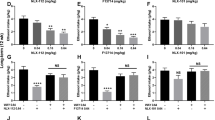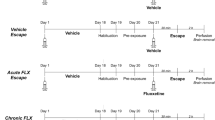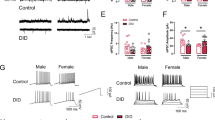Abstract
Rationale
The anxiolytic effect of ethanol is generally considered to be causally related to the development of alcohol dependence, and serotonin (5-HT) has been involved in both alcohol abuse and anxiety disorders. Several lines of evidence suggest an inverse relationship between alcohol abuse and central serotonergic neurotransmission.
Objectives
When tested in the elevated plus-maze, selectively bred Sardinian alcohol-preferring (sP) rats display a higher degree of anxiety than Sardinian alcohol-non-preferring rats (sNP); this behavior is reversed by voluntary ethanol intake. The present study examined whether sP rats differed with respect to the 5-HT innervation in different forebrain areas.
Methods
We performed an immunohistochemistry study using an antibody raised against serotonin transporter (SERT), a marker for 5-HT fibers, coupled with an unbiased stereology, the method used to count the number of 5-HT neurons in the raphe nuclei.
Results
The SERT-positive innervation density was found to be significantly lower in the medial-prefrontal cortex and in the shell of the nucleus accumbens of the ethanol-naive sP rats (sP-N) when compared with the sNP and unselected Wistar rats. No differences were found in the caudate putamen and hippocampus. The stereological analysis showed a significant difference in the number of 5-HT neurons in the dorsal but not in the median raphe of sP-N rats, compared with sNP and Wistar rats. Analysis of the cell body cross-sectional area revealed no differences among the three lines of rats either in the dorsal or in the median raphe. In sP rats that had voluntarily drunk ethanol for 14 consecutive days (sP-exp), no differences were found in the 5-HT innervation relative to sP-N animals.
Conclusions
These results indicate a selective reduction of innervation in the medial portion of the mesocorticolimbic 5-HT system in sP rats, suggesting that this genetically determined difference may be involved in the contrasting alcohol preference and consumption of sP and sNP animals.







Similar content being viewed by others
References
Arendt T, Henning D, Gray JA, Marchbanks R (1988) Loss of neurons in the rat basal forebrain cholinergic projection system after prolonged intake of ethanol. Brain Res Bull 21:563–570
Bjorklund L, Stromberg I (1997) Dopaminergic innervation of striatal grafts placed into different sites of normal striatum: differences in the tyrosine hydroxylase immunoreactive growth pattern. Exp Brain Res 113:13–23
Campanelli C, Dzung Z, Khanna J, Kalant H (1988) Effect of raphe lesions on the development of acute tolerance to ethanol and pentobarbital. Psycopharmacology 96:454–457
Casu MA, Dinucci D, Colombo G, Gessa GL, Pani L (2002) Reduced DAT and DBH immunostaining in the limbic system of Sardinian alcohol-preferring rats. Brain Res 948:192–202
Ciccocioppo R, Panocka I, Stefanini E, Gessa GL, Massi M (1995) Low responsiveness to agents evoking 5HT2 receptor-mediated behaviors in Sardinian alcohol-preferring rats. Pharmacol Biochem Behav 51:21–27
Ciccocioppo R, Panocka I, Froldi R, Colombo G, Gessa GL, Massi M (1999a) Antidepressant-like effect of ethanol revealed in the forced swimming test in Sardinian alcohol-preferring rats. Psychopharmacology 144:151–157
Ciccocioppo R, Angeletti S, Colombo G, Gessa GL, Massi M. (1999b) Autoradiographic analysis of 5HT2A binding sites in the brain of Sardinian alcohol-preferring and -nonpreferring rats. Eur J Pharmacol 373:13–19
Cloninger CR (1987) Neurogenetic adaptive mechanisms in alcoholism. Science 236:410–416
Collins MA, Corso TD, Neafsey EJ (1996) Neuronal degeneration in rat cerebrocortical and olfactory regions during subchronic “binge” intoxication with ethanol: possible explanation for olfactory deficits in alcoholics. Alcohol Clin Exp Res 20:284–292
Colombo G (1997) Ethanol drinking behaviour in Sardinian alcohol-preferring rats. Alcohol Alcohol 32:443–453
Colombo G, Agabio R, Lobina C, Reali R, Zocchi A, Fadda F, Gessa GL (1995) Sardinian alcohol-preferring rats: a genetic animal model of anxiety. Physiol Behav 57:1181–1185
Dackis CA, Gold MS (1985) New concepts in cocaine addiction: the dopamine depletion hypothesis. Neurosci Biobehav Rev 9:469–477
Devoto P, Colombo G, Stefanini E, Gessa GL (1998) Serotonin is reduced in the frontal cortex of Sardinian ethanol-preferring rats. Alcohol Alcohol 33:226–229
Fox NC, Freeborough PA, Rossor MN (1996) Visualisation and quantification of rates of atrophy in Alzheimer’s disease. Lancet 348:94–97
Gawin FH (1991) Cocaine addiction: psychology and neurophysiology. Science 251:1580–1586
Eriksson E, Humble M (1990) The biological basis of psychiatric treatment. In: Pohl R, Gershon S (eds) Progress in basic clinical pharmacology 3. Karger, Amsterdam, pp 66–119
Gessa GL, Colombo G, Fadda F (1991) Rat lines genetically selected for differences in voluntary ethanol consumption. In: Meltzer HY, Nerozzi D (eds) Current practices and future developments in the pharmacotherapy of mental disorders. Elsevier, Amsterdam, pp 193–200
Graeff FG, Guimares FS, De Andrade TG, Deakin JFW (1996) Role of 5-HT in stress, anxiety and depression. Pharmacol Biochem Behav 54:129–141
Gundersen HJG, Bagger P, Bendsten TF, Evans S, Korbo L, Marcussen N, Meller A, Nielsen K, Nyengaard B, Serensen FB, Vesterby A, West M (1988) The new stereological tools: disector, fractionator, nucleator and point sampled intercepts and their use in pathological research and diagnosis. APMIS 96:857–881
Harris GC, Altomare K, Aston-Jones G (2001) Preference for a cocaine-associated environment is attenuated by augmented accumbal serotonin in cocaine withdrawn rats. Psychopharmacology 156:14–22
Heimer L, Zahm DS, Churcill L, Kalivas PW, Wohltmann C (1991) Specificity in the projection patterns of accumbal core and shell in the rat. Neuroscience 41:89–125
Holman RB, Snape BM (1985) Effects of ethanol on 5-hydroxy-tryptamine release from rat corpus striatum in vivo. Alcohol 2:249–253
Khanna JM, Kalant H, Le AD, LeBlanc AE (1979) Effect of modification of brain serotonin (5-HT) on ethanol tolerance. Alcohol Clin Exp Res 3:353–358
Koob GF (1999) The role of the striatopallidal and extended amygdala systems in drug addiction. Ann N Y Acad Sci 877:445–460
Koob GF, Bloom FE (1988) Cellular and molecular mechanisms of drug dependence. Science 242:715–723
LaBuda CJ, Fuchs PN (2000) Aspirin attenuates the anxiolitic actions of ethanol. Alcohol 21:287–290
Le AD, Khanna JM, Kalant H, LeBlanc AE (1981) The effect of lesions in the dorsal, median and magnus raphe nuclei on the development of tolerance to ethanol. Pharmacology 218:525–529
Lovinger DM (1999) 5-HT3 receptors and the neural actions of alcohols: an increasingly exciting topic. Neurochem Int 35:125–130
Lundqvist C, Alling C, Knoth R, Volk B (1995) Intermittent ethanol exposure of adult rats: hippocampal cell loss after one month of treatment. Alcohol Alcohol 30:737–748
Maldonado-Irizarry CS, Kelley AE (1995) Excitatory amino acid receptors within nucleus accumbens subregions differentially mediate spatial learning in the rat. Behav Pharmacol 6:527–539
Mann JJ, Malone KM, Diehl DJ, Perel J, Cooper TB, Mintun MA (1996) Demonstration in vivo of reduced serotonin responsivity in the brain of untreated depressed patients. Am J Psychiatry 153:174–182
Markou A, Kosten TR, Koob GF (1998) Neurobiological similarities in depression and drug dependence: a self medication hypothesis. Neuropsychopharmacology 18:135–174
Massou JM, Trichard C, Attar-Levy D, Feline A, Corruble E, Beaufils B, Martinot JL (1997) Frontal 5HT2 receptors studied in depressive patients during chronic treatment by selective serotonin reuptake inhibitors. Psychopharmacology 133:99–101
McBride WJ, Chernet E, Rabold JA, Lumeng L, Li TK (1993) Serotonin-2 receptors in the CNS of alcohol-preferring and -nonpreferring rats. Pharmacol Biochem Behav 46:631–636
McBride WJ, Guan XM, Chernet E, Lumeng L, Li TK (1994) Regional serotonin1A receptors in the CNS of alcohol-preferring and -nonpreferring rats. Pharmacol Biochem Behav 49:7–12
Meert TF, Awouters F, Melis WJC, Janssen PAJ (1990) Ritanserin reduces alcohol intake in rats given the choice between 3% alcohol and water. Pharmacology 9:63–69
Melchior CL, Myers RD (1976) Genetic differences in ethanol drinking of the rat following injection of 6-OHDA, 5,6-DHT or 5,7-DHT in to the cerebral ventricles. Pharmacol Biochem Behav 5:66–72
Melchior CL, Tabakoff B (1986) The effect of 5,7 dihydroxy-tryptamine treatment on the response to ethanol in mice. Pharmacology 24:955–961
Myers RD, Melchior CL (1975) Alcohol drinking in the rat after destruction of serotoninergic and catecholaminergic neurons in the brain. Res Commun Chem Pathol Pharmacol 10:363–378
Mounton PR (2002) Principles and practices of unbiased stereology, an introduction for bioscientists. The Johns Hopkins University Press, Baltimore
Murphy JM, McBride WJ, Lumeng L, Li TK (1982) Regional levels of monoamines in alcohol-preferring and –nonpreferring lines of rats. Pharmacol Biochem Behav 16:145–149
Murphy JM, McBride WJ, Lumeng L, Li TK (1987) Contents of monoamines in forebrain regions of alcohol-preferring (P) and -nonpreferring (NP) lines of rats. Pharmacol Biochem Behav 26:389–392
Panocka I, Massi M (1992) Long-lasting suppression of alcohol preference in rats following serotonin receptor blockade by ritanserin. Brain Res Bull 28:493–496
Panocka I, Ciccocioppo R, Polidori C, Massi M (1993) The nucleus accumbens is a site of action for the inhibitory effect of ritanserin on ethanol intake in rats. Pharmacol Biochem Behav 46:857–862
Panocka I, Ciccocioppo R, Polidori C, Pompei P, Massi M (1995) The 5HT4 receptor antagonist, GR113808, reduces ethanol intake in alcohol-preferring rats. Pharmacol Biochem Behav 52:255–259
Parsons LH, Koob GF, Weiss F (1996) Extracellular serotonin is decreased in the nucleus accumbens during withdrawal from cocaine self-administration. Behav Brain Res 73:225–228
Paxinos G, Watson C (1986) The rat brain in stereotaxic coordinates, 2nd edn. Academic Press, New York
Pierce RC, Kalivas PW (1995) Amphetamine produced sensitized increases in locomotion and extracellular dopamine preferentially in the nucleus accumbens shell of rats administered repeated cocaine. J Pharmacol Exp Ther 275:1019–1029
Portas CM, Devoto P, Gessa GL (1994) Effect of ethanol on extracellular 5-hydroxytryptamine output in rat frontal cortex. Eur J Pharmacol 270:123–125
Prunell M, Escorihuela RM, Fernandez-Teruel A, Nunez JF, Tobena A (1994) Differential interactions between ethanol and Ro15-4513 on two anxiety tests in rats. Pharmacol Biochem Behav 47:147–151
Pulvirenti L, Berrier R, Kriefeldt M, Koob GF (1994) Modulation of locomotor activity by NMDA receptors in the nucleus accumbens core and shell regions of the rat. Brain Res 664:231–236
Sellers EM, Higgins GA, Sobell MB (1992) 5-HT and alcohol abuse. Trends Pharmacol Sci 13:69–75
Sterio DC (1984) The unbiased estimation of number and sizes of arbitrary particles using the disector. J Microsc 134:127–36
Weiss F, Markou A, Lorang MT, Koob GF (1992) Basal extracellular dopamine levels in the nucleus accumbens are decreased during cocaine withdrawal after unlimited-access self-administration. Brain Res 593:314–328
Wong TP, Marchese G, Casu MA, Ribeiro-Da Silva A, Cuello AC, De Koninck Y (2000) Loss of presynaptic and postsynaptic structures is accompanied by compensatory increase in action potential-dependent synaptic input to layer V neocortical pyramidal neurons in aged rats. J Neurosci 20:8596–8606
Zhou FC, Bledsoe S, Li TK, Lumeng L (1991) Immunostained serotoninergic fibers are decreased in selected brain regions of alcohol-preferring rats. Alcohol 8:425–429
Zhukov VN, Varkov AI, Burov YV (1985) Effect of destruction of the brain serotoninergic system on the alcohol consumption by rats in the early period of experimental alcoholism. Bull Exp Biol Med 99 576–577
Zou JY, Martinez DB, Neafsey EJ, Collins MA (1996) Binge ethanol-induced brain damage in rats: effect of inhibitors of nitric oxide synthase. Alcohol Clin Exp Res 20:1406–1411
Author information
Authors and Affiliations
Corresponding author
Rights and permissions
About this article
Cite this article
Casu, M.A., Pisu, C., Lobina, C. et al. Immunocytochemical study of the forebrain serotonergic innervation in Sardinian alcohol-preferring rats. Psychopharmacology 172, 341–351 (2004). https://doi.org/10.1007/s00213-003-1663-z
Received:
Accepted:
Published:
Issue Date:
DOI: https://doi.org/10.1007/s00213-003-1663-z




